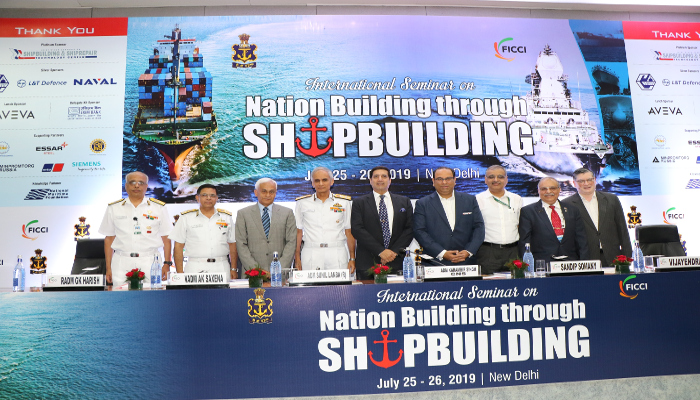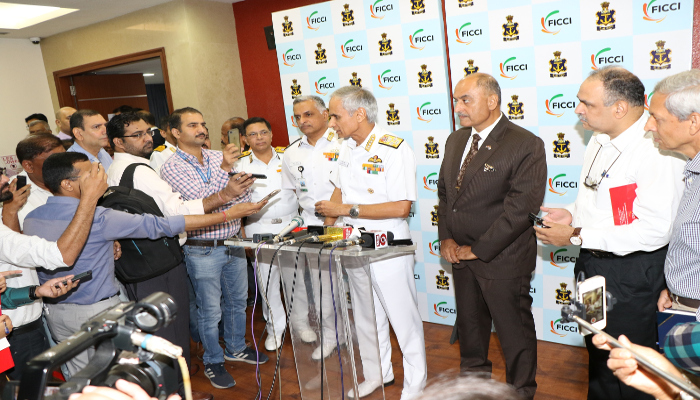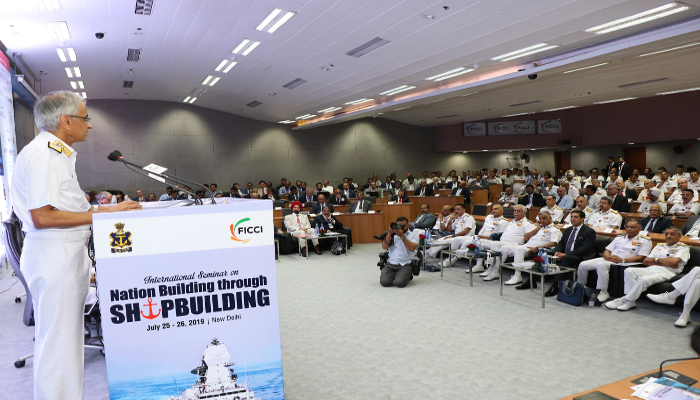
New Delhi. Naval ship-building actually contributes handsomely to economic growth and nation building and as India’s ship-building industry matures, there is immense potential to forge strategic partnerships and convert India into a strategic hub for defence ship-building exports and repairs to friendly foreign countries, said Navy Chief Admiral Karambir Singh.
Addressing a seminar on “Nation Building through Shipbuilding” organised by trade body FICCI here, he said the Indian Navy was fully invested in encouraging an indigenous ship-building ecosystem 50 years before ‘Make in India’ became a national Mission taking formative steps towards indigenous ship-building, through creation of an in-house ‘Central Design Office’ in 1964.
“The Navy has, to date, designed more than 90 warships across 19 different classes. With more than 130 platforms constructed in Indian shipyards since the first ship INS Ajay was constructed by GRSE in 1961, Naval ship-building could be counted as one of the success stories of India. This is testimony to the synergy between the Navy and industry, as also our commitment towards self-reliance,” he said.
The Naval Chief said Naval ship-building actually contributes handsomely to economic growth and nation building and listed three reasons for it and these were ‘Plough-back’ effect, catalyst for employment generation and skill development and strategic outcomes for the nation.
He said a very large proportion of every rupee spent on the Navy is ploughed back into the Indian economy with more than 60% of the Naval budget dedicated to Capital expenditure. Nearly 70% of this Capital budget has been spent on indigenous sourcing, amounting to nearly Rs 66,000 Crores in the last five years. Since the launch of ‘Make in India’ in 2014, 80% AoNs on cost basis have been awarded to Indian vendors. Of the total 51 ships and submarines on order at various shipyards as on date, 49 are being constructed indigenously.

Each ship building project creates logistics, spares and project support ecosystems, comprising OEMs, ancillary industry, and MSMEs, to support each platform. GRSE, for instance, has nearly 2100 firms registered to support ongoing naval ship-building projects. Nearly 90% of ship repair by value is undertaken by Indian vendors, mostly MSMEs, implying that a high proportion of Navy’s Revenue, in addition to the Capital Budget, also is being ploughed back into the economy.
The second contribution of Naval ship-building is as a catalyst for employment generation and skill development, which are present-day real challenges faced by the nation.
The Navy Chief said statistics show that the multiplier effect of one worker employed in a shipyard is approximately 6.4 on ancillary industries. Project 17A frigates for instance, is expected to employ a workforce of about 4,500 workers annually within the yard, but nearly 28,000 personnel per year as outsourced manpower from ancillary industries.
He said naval ship-building projects contribute to strategic outcomes for the nation as well.

“We have already added to the capacities of friendly nations, such as Seychelles, Maldives and Sri Lanka to name a few, by exporting warships that enhance their overall security,” he said.
Admiral Singh said that to enable such strategic outcomes, however, there is a need for the nation to achieve a certain ‘critical mass’ in indigenous ship-production and ship-repair capability.
“Whilst defence ship-building plays an important role. We really need to harness the headroom available in sectors, such as mercantile marine and coastal shipping, to increase capacities and attain true potential,” he said.









